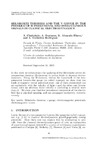
Please use this identifier to cite or link to this item:
http://ricaxcan.uaz.edu.mx/jspui/handle/20.500.11845/516| Title: | Helmholtz theorem and the V-Gauge in the problem of superluminal and instantaneous signals in classical electrodynamics |
| Authors: | Chubykalo, Andrew Espinoza, Augusto Alvarado Flores, Rolando Gutiérrez Rodríguez, Alejandro |
| Issue Date: | Feb-2006 |
| Publisher: | Foundations of Physics Letters |
| Abstract: | In this work we substantiate the applying of the Helmholtz vector decomposition theorem (H-theorem) to vector fields in classical electrodynamics. Using the H-theorem, within the framework of the twoparameter Lorentz-like gauge (so called v-gauge), we show that two kinds of magnetic vector potentials exist: one of them (solenoidal) can act exclusively with the velocity of light c and the other one (irrotational) with an arbitrary finite velocity v (including a velocity more than c) . We show also that the irrotational component of the electric field has a physical meaning and can propagate exclusively instantaneously. |
| URI: | http://hdl.handle.net/20.500.11845/516 https://doi.org/10.48779/88r6-ww76 |
| ISSN: | 1572-9524 0894-9875 |
| Other Identifiers: | info:eu-repo/semantics/publishedVersion |
| Appears in Collections: | *Documentos Académicos*-- UA Física |
Files in This Item:
| File | Description | Size | Format | |
|---|---|---|---|---|
| 2006 Found. Phys. Let..pdf | 322,66 kB | Adobe PDF |  View/Open |
This item is licensed under a Creative Commons License
